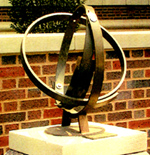| Description: |
- This is an unusual armillary sphere without the standard gnomon rod, allowing the dial to be adjusted easily to tell civil time. As generally expected of an armillary or equatorial sundial, there is an equatorial time ring (16 inches in diameter) with engraved hourly time marks fastened to a meridian ring. But for this dial the equatorial and meridian ring assembly rotates on a polar axis. The dial functions as a Pilkington & Gibbs Heliochronometer: A small hole with lens where the equatorial and meridian rings meet allows a focused spot of sunlight to fall upon the opposite side of the rings where there is a plaque engraved with an analemma and associated monthly and day marks along the curve. This assembly is an analemmic alidade, allowing the user to align the spot of sun to an offset along the analemma curve of date that adjusting the sundial for the equation of time and longitude off time zone meridian. Civil time is read on the equatorial ring from a marker located on a fixed meridian. Knowing the month and approximate day, the dial can be read to the nearest minute.
The black and white photo of the dial shows the original 1955 dial atop a brick platform with capstone. When the dial was moved to be near the Schneider bench it now sits on a stone platform with capstone and is the focus of the plaza seating area.
From a report in the NASS Compendium, March 1995: "Special difficulty encountered in its construction was finding a lens with a focal length of 16 inches that had the desired 3/8 inch diameter. Ingeniously, the problem was solved by a quick trip to a dime store where a pair of cheap reading glasses was purchased. By cutting the oversized glasses under water with a pair of scisors, the innovators fashioned their lens, which they adeptly fitted into the analemma ring. The analemma, a graduated scale shaped like a figure eight that shows the sun's declination and the equation of time for each day of the year was skillfully chiseled by hand....When the sun clock was finally completed, it was oxidized, treated and lacquered for weather resistance and lasting beauty. Unlike ordinary sundials that only approximated the [civil] time, the sun clock was unique in that it can tell time within one minute's accuracy."
"A series of mishaps and thefts plagued the clock from the time it was first set on its pedestal. In 1962 the entire sundial was stolen by a few inexperienced thieves. They weren't very clever in covering up their trail and the [sundial] was recovered a few days later....[After burglar-proofing the mount] shortly after its restoration, the sun clock became a target for vandals. First the lens was smashed. The Physical Plant replaced it, only to have it smashed again. And again they had to replace it...[and in 1968] Everything but the base was gone - and this time no culprit could be found....'Finally we decided to make an effort to replace the dial ourselves,' said Wenner, who resigned as Director in 1968 to become Utilities Coordinator ... 'even though we didn't know where the money was going to come from.' .... It wasn't long before we heard from Rosensweig, who had since become Dr. Rosensweig, and was president of the Ferrofuidics Corp. in Burlington, MA ...He said he would have to redesign the instrument entirely because he no longer had the original plans....In July 1970 the new sundial was carefully mounted on its pedestal. Since it is the tradition that every sundial should have a motto, a brass plate was affixed to the pillar and reads, "There is Time for Those Who Pass". And once again, when students are late for class, they can call on the excuse, "Sorry, but the sun was behind a cloud."
A duplicate of the armillary with the P&G type analemma correction is believed to be located on the former Kroger estate in suburban Cincinnati.
|
| |
General Information: | Inscription: | - Owner: University of Cincinnati
| - (pedestal)
Engineering Alumni Association
MMI
(plaque)
There is time for those who pass.
Presented by the Class of 1955
|
- Designer: Ronald E. Rosensweig & Hans Mueller
|
- Builder: Rief Manufacturing Co., Cincinnati, OH
|
- Construction Date: built in 1955, restored in 1970 and 2001
|
| |
| References: | Web Links: |
- Cooperative Engineer, Oct 1956, article by R. E. Rosensweig, Cincinnati Alumnus, October 1970, "Return of the Sun Clock -- A Timely Return -- How the UC's Sun-Clock Got Back on its Pedestal" in A History of the The First Cooperative College, October 1970
"A Timely Return" is reprinted in the NASS Compendium March, 1995 vol. 2-1
| |

